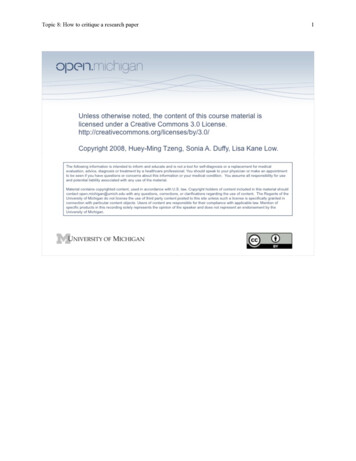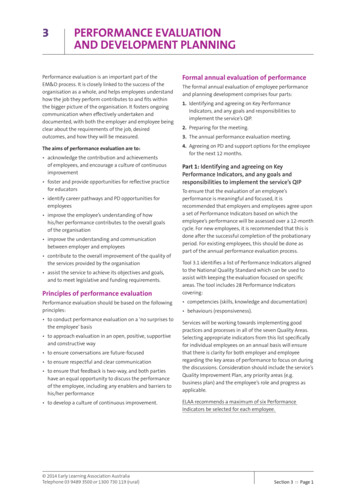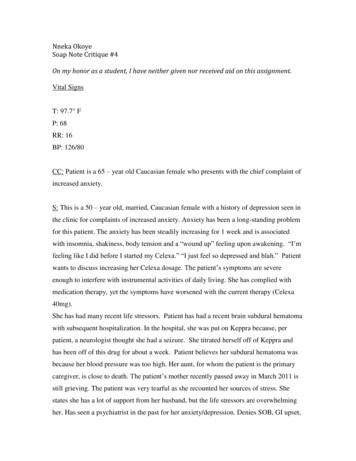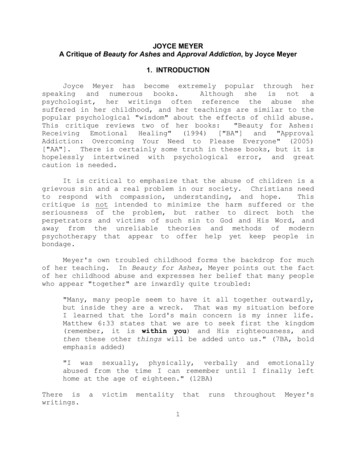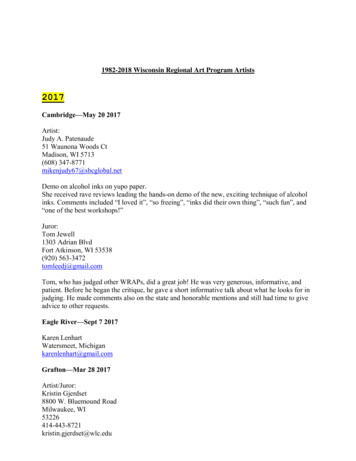
Transcription
Telephone: 250-360-1560 email: Info@vtpi.orgA Good Example ofBad Transportation Performance EvaluationA Critique of the Fraser Institute Report,“Transportation Performance of the Canadian Provinces”11 June 2009Todd LitmanVictoria Transport Policy InstituteHartgen, Chadwick and Fields assume that increased vehicle traffic per lane-kilometer iseconomically beneficial and desirable, but most people call this “congestion.”AbstractPerformance evaluation refers to a process of monitoring and analysis to determine howwell organizations perform with regard to their intended goals and objectives. Thisprovides useful guidance for planning and management decisions. Performanceevaluation must be carefully structured to accurately reflect goals. Inappropriate orincomplete evaluation can misdiagnose problems and result in bad decisions.This paper discusses transportation performance evaluation concepts and methods, andcritiques the report, Transportation Performance of the Canadian Provinces by Hartgen,Chadwick and Fields. That report uses a unique set of 23 indicators to evaluate theCanadian transport system. A few of these indicators are appropriate and widely used,but several are ambiguous and biased, and some are illogical. This paper examinesthese indicators and evaluates their appropriateness for planning and managementapplications.Presented at theInstitute of the Transportation Engineers, Vancouver Island Section30 October 2008, Victoria, British ColumbiaTodd Alexander Litman 2008You are welcome and encouraged to copy, distribute, share and excerpt this document and its ideas, provided theauthor is given attribution. Please send your corrections, comments and suggestions for improving it.
Transportation Performance IndicatorsVictoria Transport Policy InstituteIntroductionAn effective health maintenance program includes regular checkups to monitor patients’fitness and medical conditions in order to help identify, prevent and manage problems. Aresponsible patient is comforted to hear their physician report, “The checkup indicatesthat you are overall healthy, but I am recommending some actions you can take toimprove your fitness and health.”Similarly, organizations (including businesses, agencies and governments), need ongoingperformance evaluation to identify potential problems and optimize productivity. Just asphysicians track factors such as diet, body weight, blood pressure and lung capacity, goodmanagers track various factors to monitor organizational fitness and health.Performance evaluation refers to a monitoring and analysis process to determine howwell policies, programs and projects perform with regard to their intended goals andobjectives. Performance indicators (also called measures of effectiveness) are specificmeasurable outcomes used to evaluate progress toward established goals and objectives.A performance index is a set of performance indicators in a framework designed tofacilitate analysis. Commonly used performance indices include school grades, sportsratings, economic productivity indicators, and investment rating systems.Performance indices have many practical applications including trend analysis,comparisons, target setting, and incentives (such as rewards) for managers and employees.They provide a navigation system that indicates where the organization is, where it wantsto go, and how to get there. They help identify developing problems and the effectivenessof solutions.Performance indicators must be carefully selected to accurately reflect goals and identifyproblems. Inappropriate or incomplete indices can misdiagnose problems and misdirectdecision-makers. For example, an index that only considers quantity will encourageorganizations to produce abundant but inferior output, while an index that only considersquality can result in high quality but inadequate production quantity.This paper discusses transportation performance evaluation concepts and principles, andcritiques the 2008 report, Transportation Performance of the Canadian Provinces, byHartgen, Chadwick and Fields, published by the Fraser Institute, a libertarian researchorganization located in Vancouver, Canada.1
Transportation Performance IndicatorsVictoria Transport Policy InstituteTransportation Performance IndicatorsTransportation professionals have developed considerable information on performanceevaluation, including guidance for internal (within the organization) analysis (CalTrans2008; TRB 2008), strategic planning (CTE 2008), and sustainable transport planning(CST 2003; STI 2008). Conventional transportation performance indicators, such asroadway Level-of-Service (LOS) ratings and average traffic speeds, primarily consideredmotor vehicle traffic conditions (“Multi-modal LOS” VTPI). They have been criticizedfor ignoring or undervaluing other impacts and objectives, such as cost efficiency, equity,community livability and environmental quality (SFCTA 2008). In recent years, manytransport organizations have developed more comprehensive performance indicator setsthat better reflect diverse planning goals and objectives (WSDOT 2008; Litman 2007).Good performance indices reflect the following principles (FHWA 2000; CST 2003): Include various goals and perspectives.Effectively indicate how well goals and objectives are being met.Are clearly defined.Are simple, understandable, logical, and repeatable.Can be collected economically.Are suitable for trend and comparative analysis.Are accessible, understandable and useful to decision-makers and other stakeholders.Transportation performance evaluation should generally be based on accessibility (theability to reach desired services and activities) rather than just mobility (physicalmovement), because access is the ultimate goal of most transport activity (Levinson andEl-Geneidy 2006; Litman 2003; “Accessibility,” VTPI 2008). Mobility is one factor thataffects accessibility, but other factors are also important, including land use patterns andmobility substitutes such as electronic communication. Mobility-based performanceevaluation can lead to planning decisions that increase vehicle travel and associated costsbut fail to improve overall accessibility. For example, automobile-oriented transportationimprovements, such as road and parking expansion, and highway-oriented land usedevelopment, tend to reduce walking, cycling and public transit access and increase traveldistances, reducing overall accessibility, particularly for non-drivers. In many situations,overall accessibility can be improved in ways that reduce total motor vehicle travel byimproving alternative modes and creating more accessible and multi-modal land usedevelopment patterns. Accessibility-oriented indicators will recognize these benefits, butmobility-oriented indicators will not.There are three general types of performance indicators: Service quality – These reflect the quality of service experienced by users. Outcomes – These reflect outcomes or outputs. Cost efficiency – These reflect the ratio of inputs (costs) to outputs (desired benefits).2
Transportation Performance IndicatorsVictoria Transport Policy InstituteEach type is important. Service quality reflects users’ perspectives. Outcomes reflectplanning objectives. Cost efficiency reflects economic performance. Table 1 illustratesexamples of these indicators for various transport modes. Level-Of-Service (LOS) ratingsare now available for evaluating most modes (“Multi-Modal LOS” VTPI, 2008).Table 1ModeWalkingCyclingAutomobilePublic transitTaxiMulti-modalExamples of Performance Indicators for Various ModesService QualityOutcomesCost EfficiencySidewalk/path supplyPedestrian mode splitCost per sidewalk-kmPedestrian LOSAvg. annual walk distanceCost per walk-kmCrosswalk conditionsPedestrian crash ratesCost per capitaBike path and lane supplyBicycle mode splitCost per path-kmCycling LOSAvg. annual cycle distanceCost per cycle-kmPath conditionsCyclist crash ratesCost per capitaRoadway supplyAvg. auto trip travel timeCost per lane-kmRoadway pavement conditionCost per vehicle-kmRoadway LOSVehicle energy consumptionand pollution emissionsParking availabilityMotor vehicle crash ratesExternal cost per capitaTransit supplyTransit mode splitUser cost per pass.-kmTransit LOSPer capita transit travelUser cost per capitaTransit stop and station qualityAvg. transit trip travel timeSubsidy per capitaFare affordabilityTransit crash and assault ratesTaxi supplyTaxi useCost per taxi-tripAverage response timeTaxi crash and assault ratesExternal costsTransport system integrationTotal transportation costsTotal cost passenger-kmAccessibility from homes tocommon destinationsTotal average commute timeTotal cost per capitaTotal crash casualty ratesExternal cost per capitaAirport supplyAir travel useCost per tripAir travel service frequencyAir travel crash ratesExternal costsUser cost per capitaUser survey resultsAviationAir travel reliabilityRailMarineAirport subsidiesRail line supplyRail mode splitCost per rail-kmRail service speed andreliabilityRail traffic volumesCost per tonne-kmRail crash ratesExternal costsMarine service supplyMarine mode splitCost per tonne-kmMarine service speed andreliabilityMarine traffic volumesSubsidiesMarine accident ratesExternal costsThis table illustrates various types of performance indicators.3
Transportation Performance IndicatorsVictoria Transport Policy InstituteMost indicators use reference units, measurement units normalized for comparingimpacts, such as per capita, per kilometer, per trip, per vehicle and per dollar. Theselection of reference units can affect how problems are defined and which solutions areconsidered. For example, distance-based units, such as per vehicle-kilometer favor ruraland suburban conditions, where residents own more vehicles, drive greater distances athigher speeds, and have lower per-mile crash rates than in urban areas. Measuringimpacts per trip or per capita favors urban conditions where residents own fewer vehicles,have more nearby destinations, use alternative modes more, and have less severe crashes.With distance-based reference units such as per-kilometer- fuel-consumption and trafficfatalities-per-billion-vehicle-kilometers, performance ratings tend to improve withincreased annual vehicle mileage. Per-capita units measure total impacts, which doincrease with mileage. Distance-based units ignore the increases in total consumer costs,accidents and pollution emission problems caused by increased vehicle travel, and thebenefits of strategies that reduce total vehicle travel. Similarly, distance-based unitsignore the potential benefits of strategies that improve High Occupant Vehicle (HOV)travel. For example, HOV lanes may carry a relatively small portion of total vehiclekilometers, and so appear inefficient if measured in this way, but carry a larger portion ofpassenger-kilometers, and reduce total travel time and vehicle costs.For these reasons, per capita and annualized per capita are generally the best referenceunits for evaluating overall costs and risks. Other reference units may be appropriate forevaluating specific projects. For example, congestion reduction impacts on a particularcorridor can be evaluated per additional peak-period person trip accommodated.Performance evaluation should also account for differences in conditions and demands.Like should be compared with like, or comparisons should include adjustment factorsthat account for geographic, demographic or economic differences. For example, urbanroadways experience heavy traffic volumes and congestion, while many rural roadsreceive little use. As a result, urban roadways have high construction and maintenancecosts per lane-kilometer, but low costs per vehicle-kilometer because the costs aredivided by many vehicle-kilometers. Similarly, high urban traffic densities result inrelatively high per-kilometer crash rates in cities, but these tend to be lower-speed crashes.Rural driving has lower crash frequencies but greater crash severities and more drivingper capita, resulting in higher per capita traffic fatality rates in rural areas. As a result, itis inappropriate to compare urban and rural indicator values without acknowledging thesedifferences and how the selection of reference units can affect results. Similarly, roadwayperformance analysis should account for the substantial differences in construction andmaintenance costs between flatland and mountainous conditions, and freight performanceevaluation should take into account differences in handling costs between bulk andmanufactured goods. Failure to account for such differences in comparative analysisresults in inaccurate results and unfair ratings.4
Transportation Performance IndicatorsVictoria Transport Policy InstituteA Good Example of Bad IndicatorsThe 2008 report, Transportation Performance of the Canadian Provinces, by Hartgen,Chadwick and Fields published by the Fraser Institute uses a unique set of 23 indicatorsto evaluate and compare transportation system performance of Canadian provinces. Thereport’s stated intent is to improve transportation performance nationwide by establishingkey baseline information that can be used to track performance over time. The reportrates provinces from best to worst with regard to specific indicators and aggregate indices.The authors provide little information about how their index was created. A project likethis usually starts with a review of existing literature, discussing what the authorsconsider good and bad about various approaches, and specific descriptions of how theyselected their indicators. Although the authors list numerous references from popular andtechnical sources, they mention none of the performance evaluation guides by leadingtransportation professional organizations (OTM 2008; WSDOT 2008; TRB 2008), andalthough they provide general comments about performance evaluation they offer nodetails about the indicators they considered and their selection process.Table 2 shows their performance index. Although some indicators are appropriate andcommonly used, others are ambiguous, and a few are illogical for comparative analysis.For example, the safety indicator (fatality rate per billion vehicle km) and congestionindicator (annual hours of delay per capita) are widely used, but the roadway indicator(vehicle kilometers of travel per two-lane kilometer of road) is ambiguous (a higher valuecould indicate cost efficiency or inadequate roadway supply and congestion) andinherently favors more urbanized provinces over more rural provinces.The highway cost efficiency indicator (provincial expenditures per kilometer of majorroad) favors provinces with inexpensive, low-volume roads, although the results wouldbe reversed if based on expenditures per vehicle-kilometer, which recognizes that theeconomic value of roads results from their use. Aviation indicators (passengers andtonnes of cargo per flight) favor provinces with major airports. A road freight efficiencyindicator (Total employment per truck border crossing) is ambiguous, and rail and marineindicators (Origin tonnes per km of first line track and Port operator expenditures pertonne handled) ignore differences in handling costs between different types of freight. Itimplies a province that ships more bulk goods (such as aggregates and potash) has a moreproductive transport system than one that ships high value manufactured goods.The study evaluates safety using distance-based indicators such as fatality rate per billionvehicle km, which as mentioned earlier, ignores the safety impacts of changes in vehicletravel. Per capita fatality rates are more appropriate to measure overall risk, and allowtraffic accidents to be compared with other health risks. Congestion costs are measuredper capita, as is appropriate. Although government costs are included, there are noindicators of user costs or affordability (such as per capita transport expenditures, ortransit and airline fares relative to incomes), business costs (such as parking facility costsand subsidies), user convenience or comfort (such as transit service quantity andcrowding), or environmental impacts (such as air and noise pollution).5
Transportation Performance IndicatorsVictoria Transport Policy InstituteTable 2ModePerformance Index (Hartgen, Chadwick and Fields afetyMeasureweightModal weightGrand weight(trips or tonnes)(trips & tonnes)90%km of travel per two-lane km ofroadProvincial expenditures per km,major roadPercent of major roads in fair orpoor conditionTravel time to OttawaTravel time to US borderFatality rate per billion veh-kmAnnual hours of delay per capitaAvg. round trip commute timeRidership per capita servedOperating cost per tripPassengers per flightAccidents per million passengersNot evaluatedGovernment operating cost perpassengerAccidents per million ureSafetyTradeTonnes of truck traffic per km ofroadFatal collisions per million tonnesTotal employment per truck bordercrossingTonne of cargo per flightOrigin tonnes per km of first linetrackRail accidents per millionoriginating tonnesPort operator expenditures pertonne handledPort expense/revenue ratioShipping accidents per mill. /31/3This table summarizes the performance indicators used by Hartgen, Chadwick and Fields.Because the index gives passenger transport 90% of the total weight, and highwaytransportation 96.5% of that, highway transport receives 87% of total weight. Theseweights are based on each mode’s share of trips, although for economic analysis theyshould be weighted based on value, which would raise the importance of air and freighttransport, and perhaps public transit. This weighting favors lower-value transport, such asbulk goods movement over higher value transport. For example, it assumes that apercentage improvement in highway travel speed, safety and cost efficiency is muchmore important than the same proportional improvement to other modes.6
Transportation Performance IndicatorsVictoria Transport Policy InstituteThe index assumes that increased vehicle travel per roadway kilometer is desirable and sofavors policies that encourage driving such as more dispersed land use development(sprawl), minimal fuel prices and road tolls, and minimal provision of alternative modes.Roadway cost efficiency is evaluated based on provincial expenditures per roadkilometer, which favors construction of more low-cost roads, offloading costs to otherlevels of government, and toll financing. Those may be appropriate, but are notnecessarily indicators of overall improvement in transport system performances.The study includes highway access indicators (travel times to Ottawa, the U.S. borderand for commuting) but no comparable indicators for other modes. This reflects amisunderstanding of the concept of accessibility, which is multi-modal. There are noindicators of non-motorized travel, although walking and cycling have greater modeshare than many of the modes the study includes. Public transit gets only 3% of theweight of highway transport. Although it considers transit ridership desirable, usercomfort and safety are not measured and transit service cost minimization is favoured. Noor cheap transit service is considered better than comprehensive transit service providingbasic mobility over a broad area, or high quality urban transit service designed to attracttravelers who would otherwise drive on congested highways. Similarly, air, rail, ferry,and the various forms of freight transport would only receive modest support, due to theirlow weights. The index favors cheap ferry services (acknowledging that ferry servicecosts are really incomparable, the study arbitrarily reduces New Brunswick,Newfoundland and Labrador ferry performance ratios).The report indicates that British Columbia has a relatively high traffic crash rate.Although British Columbia has a 49% higher fatality rate than the national averagemeasured by distance (13.9 versus 9.3 deaths per billion vehicle-kilometers), it is only19% higher when measured per capita (10.8 versus 9.1), which is generally a betterindicator of overall risk and transport system performance as previously discussed.Traffic Accidents1Traffic DeathsFigure 116Canada14British Columbia121086420Per Billion Veh-KmsPer 100,000 ResidentsBritish Columbia has a relatively high distance-based crash rate but less if measured per capita.1Canadian Motor Vehicle Traffic Collision Statistics 7
Transportation Performance IndicatorsVictoria Transport Policy InstituteTwo indicators are particularly illogical: Travel time to Ottawa and Travel time to USborder. Although accessibility indicators (such as jobs within 30 minute commute ofhomes) are appropriate and increasingly used to evaluate transport systems (Levinson andEl-Geneidy 2006), these are inappropriate because they assume: Canada has only two economically important destinations: Ottawa and the U.S. In fact,Canada has many regions each with multiple economic activity centers. Economicsuccess requires access to diverse destinations within and between regions. Ottawa is Canada’s economic center. Although a major administrative center, it has onlymodest economic importance. If a single city were to be selected, it should be Toronto. All travelers drive to Ottawa, although most (particularly business and wealthy touristswho have the most economic importance) generally fly when traveling longer distances.Consider the transport policies and conditions these indicators imply are desirable: Km of travel per two-lane km of road. Vehicle travel should be encouraged and concentratedon minimal road kilometers. Provinces with busier roads have better transport systems thanprovinces with lower-volume roads. Annual hours of congestion delay per capita and average commute times. Rural areas havebetter, more productive transport systems than dense, urban areas with heavy commutevolumes, although cities actually tend to have higher per capita economic productivity. Provincial expenditures per km of major road. Provinces should minimize highwayexpenditures even if that reduces service quality or off-loads costs to other levels ofgovernments. Provinces with better highways and more challenging terrain are inferior. Travel time to Ottawa and Travel time to US border. Central and southern provinces havebetter transport systems than western, eastern and northern provinces. Total employment per truck border crossing. Provinces should minimize border crossings. Government costs per ferry trip. Provinces should only subsidize short, high volume routes. Port operator expenditures per tonne handled. A province is more productive if it transportseasily handled products (for example, coal rather than automobiles).Unsurprisingly, the study ranks Ontario first (it has the fastest highway travel time toOttawa, is highly urbanized and is a major transfer center); British Columbia last forpersonal transport (it is distant from Ottawa and has many costly, mountainous roads);and Newfoundland and Labrador last for freight transport (they have minimal rail and airfreight volumes). These conclusions are meaningless. The study’s analysis may beprecise (calculated to several significant figures), but useless for planning andmanagement applications. For example, unless the British Columbia Ministry ofTransportation can move the province closer to Ottawa, highway travel time to that cityindicates nothing about the provinces’ transport planning problems and priorities.Similarly, unless its provincial government can make Newfoundland and Labrador intomajor rail and air freight transport hubs, its ranking by this methodology will stay low.8
Transportation Performance IndicatorsVictoria Transport Policy InstituteTable 3 critiques Hartgen, Chadwick and Fields’ index. Many of their indicators areambiguous and biased. Only a few are really useful for transport planning. The index hassignificant omissions. Below are examples of indicators that could be added to moreaccurately reflect overall transport system performance: Nonmotorized transport service quality indicators (sidewalk, crosswalk and pathsupply, facility quality, safety). Public transit service quality indicators (service supply, crowding, safety andaffordability) Freight transport value (rather than volume). Energy consumption and efficiency. Consumer transportation costs and affordability. Pollution emissions. Quality of mobility for non-drivers (universal design of sidewalks and transit services,paratransit availability, fare discounts for disadvantaged populations). Accessibility (portion of jobs and affordable housing located in areas with nearbyservices, walkability, bike paths and transit services).The authors acknowledge that their index is arbitrary and incomplete and so offer thefollowing defence:Of course, some provincial road managers would immediately point out that the provincesare not comparable. For example, British Columbia has road traffic, congestion, cost-ofbusiness, weather, terrain, and climatic conditions that are vastly different fromSaskatchewan. That might be, but other provinces might counter that they do not have thefiscal resources that the more populous provinces have and, therefore, are constrained as toactions they can take. Following this logic, one would be quickly led to the absurdconclusion that no comparisons between provinces are ever possible. Our view is that, evenwith different circumstances, each province is responsible for the road system’s upkeep andexpansion using the resources it has. And each province is dependent on others foraccessibility, since modal systems connect provinces. Therefore, a measure that shows howmuch each province has to work with, relative to system and size, is a useful comparativemeasure of resources that should translate into results.This fails to enlighten. The wording is unclear, particularly the last sentence. It impliesthat only a few “road managers” would question the study’s assumptions and methods. Itappears to argue that since performance must be evaluated, any index can be used forcomparison, regardless of how arbitrary and biased. This is irrational and unfair,particularly if results are used to rate organizations or jurisdictions as good and bad, asHartgen, Chadwick and Fields do, rather than simply a time series analysis of individualjurisdictions.9
Transportation Performance IndicatorsVictoria Transport Policy InstituteTable 3Performance Index Evaluation SummaryIndicatorCritiqueFavors (Direction of Bias)GradeKilometers of vehicle travel pertwo-lane km of roadAmbiguous. Could indicateinadequate road supply.Urban conditions andincreased vehicle traffic.DProvincial expenditures permajor road kilometerInappropriate. Ignores geographicand traffic volume differences.Rural conditions, and cheap,inferior roads.CPercent of major roads in fair orpoor conditionAppropriateRoadway travel time to OttawaInappropriate. Misrepresents theconcept of access.Central provinces, particularlyOntario and Quebec.FRoadway travel time to USborderInappropriate. Misrepresents theconcept of access.Southern provinces.FTraffic fatality rate per billionvehicle-kmsMobility-based.Increased motor vehicle travel.CAnnual hours of congestiondelay per capitaAppropriate, but data are limited toa few cities.Provinces with few largecities.BAverage round trip commutingtimeInappropriate as a road indicator;should apply to all modes.Smaller cities and rural areas.BTransit ridership per capitaservedAppropriate if one of several transitquality indicators.Larger cities.BATransit operating cost per tripAppropriate.Larger cities.BAviation passengers per flightInappropriate. Misrepresents theconcept of load factor.Cities with major airports.DAviation accidents per millionpassengersAppropriate.Government operating cost perferry passengerInappropriate. Ignores differencesin costs.Accidents per million ferrypassengersAppropriate.Tonnes of truck traffic per kmof roadAmbiguous. Could indicateinadequate roads.Urban areas and increasedfreight truck volumes.DFatal collisions per milliontonnesMobility-based.Increased motor vehicle travel.BTotal employment per truckborder crossingInappropriate. Providesmeaningless information.Provinces with more jobs andfewer border crossings.FTonnes of cargo per flightInappropriate. Misrepresents theconcept of load factor.Cities with major airports.DOrigin tonnes per km of firstline trackAmbiguous. Indicates little abouttrue cost efficiency.Provinces that generate highrail freight volumes.CRail accidents per millionoriginating tonnesAppropriate.Port operator expenditures pertonne handledAmbiguous. Indicates little abouttrue cost efficiency.Provinces with cheaper-tohandle marine freight.DPort expense/revenue ratioAppropriate, but fails to account forfactors such as investment.Provinces not currentlyimproving port facilities.BShipping accidents per milliontonnesFails to account for different typesof freightProvinces with safer-to-handlemarine freight.BAProvinces with shorter andcheaper ferry services.DAAThis table critiques performance indicators used by Hartgen, Chadwick and Fields.10
Transportation Performance IndicatorsVictoria Transport Policy InstitutePerformance Index BiasOverall, Hartgen, Chadwick and Fields’ performance index favors mobility overaccessibility and automobile transport over other modes, as indicated by the use ofvolume and distance-based indicators which assume that increased vehicle travelimproves transport system performance and imposes no additional costs or risks. Thereport provides no discussi
The 2008 report, Transportation Performance of the Canadian Provinces, by Hartgen, Chadwick and Fields published by the Fraser Institute uses a unique set of 23 indicators to evaluate and compare transportation system performance of Canadian provinces. The report's stated intent is to improve transportation performance nationwide by establishing
